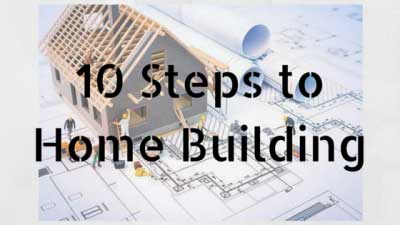Home Building Process is exciting, especially when you understand how the process works. The following overview outlines the typical steps your builder will take in the construction of a home and will help keep you abreast of what happens at key stages.
- Prepare site and pour foundation:Often, site preparation and foundation work are performed by the same crew, but this may not be the case with a wooded lot. Using a backhoe and a bulldozer, the crew clears the site of rocks, debris and trees for the house and, if applicable, the septic system. The crew levels the site, puts up wooden forms to serve as a template for the foundation, and digs the holes and trenches. Footings (structures where the house interfaces with the earth that supports it) are installed. If your home is going to have a well, it will be dug at this point.
Home INSPECTION #1:
When the curing process is complete, a city inspector visits the site to make sure foundation components are up to code and installed properly. This inspection may be repeated depending on the type of foundation (slab, crawl space or basement). Your builder will then remove the forms and begin coordinating step 2, the framing phase.
- Complete rough framing:The floor systems, walls and roof systems are completed (collectively known as the shell or skeleton of the house). Plywood or oriented strand board (OSB) sheathing is applied to the exterior walls and roof, and windows and exterior doors are installed. The sheathing is then covered with a protective barrier known as a house wrap; it prevents liquid water from infiltrating the structure, while allowing water vapor to escape. This reduces the likelihood of mold and wood rot.
- Complete rough plumbing, electrical and HVAC:Once the shell is finished, siding and roofing can be installed. At the same time, the electrical and plumbing contractors start running pipes and wires through the interior walls, ceilings and floors. Sewer lines and vents, as well as water supply lines for each fixture, are installed. Bathtubs and one-piece shower/tub units are put in place at this point because there’s more room to maneuver large, heavy objects.
Ductwork is installed for the heating, ventilation and air-conditioning (HVAC) system, and possibly the furnace. HVAC vent pipes are installed through the roof, and insulation is installed in the floors, walls and ceilings.
Note that HVAC ducts and plumbing are usually installed before wiring, because it’s easier to run wires around pipes and ducts than vice versa.
INSPECTIONS 2, 3 and 4: Rough framing, plumbing and electrical and mechanical systems are inspected for compliance with building codes. Most likely these will be three different inspections. At the very least, the framing inspection will be conducted separately from the electrical/mechanical inspections.
At this stage, drywall (also known as plasterboard, wallboard or gypsum board) is delivered to the building site. Sheetrock®, a registered trademark of USG Corporation, is sometimes used as a generic term for drywall.
- Install insulation:Insulation plays a key role in creating a more comfortable, consistent indoor climate while significantly improving a home’s energy efficiency. One of the most important qualities of insulation is its thermal performance or R-value, which indicates how well the material resists heat transfer. Most homes are insulated in all exterior walls, as well as the attic and any floors that are located above unfinished basements or crawl spaces.
- Complete drywall and interior textures; start exterior finishes:Drywall is hung and taped so the seams between the boards aren’t visible, and drywall texturing (if applicable) is completed. The primer coat of paint is also applied after taping is complete. Contractors begin installing exterior finishes such as brick, stucco, stone and siding.
- Finish interior trim; install exterior driveways and walkways:Interior doors, baseboards, door casings, window sills, moldings, stair balusters and other decorative trim are installed, along with cabinets, vanities and fireplace mantels and surrounds. Walls get a finish coat of paint and are wallpapered where applicable.
- Install hard-surface flooring and countertops; complete exterior grading:Ceramic tile, vinyl and wood flooring are installed as well as countertops. Exterior finish grading is completed to ensure proper drainage away from the home and prepare the yard for landscaping.
- Finish mechanical trims; install bathroom fixtures:Light fixtures, outlets and switches are installed and the electrical panel is completed. HVAC equipment is installed and registers completed. Sinks, toilets and faucets are put in place.
- Install mirrors, shower doors and finish flooring; finish exterior landscaping:Mirrors, shower doors and carpeting are installed, and final cleanup takes place. Trees, shrubs and grass are planted and other exterior landscaping completed.
INSPECTION #5: A building-code official completes a final inspection and issues a certificate of occupancy (C.O.). If any defects are found during this inspection, a follow-up inspection may be scheduled to ensure that they’ve been corrected.
- Final walkthrough:Your builder will walk you through your new home to acquaint you with its features and the operation of various systems and components, and explain your responsibilities for maintenance and upkeep as well as warranty coverage and procedures. This is often referred to as a pre-settlement walkthrough. It’s also an opportunity to spot items that need to be corrected or adjusted, so be attentive and observant. Examine the surfaces of countertops, fixtures, floors and walls for possible damage. Sometimes disputes arise because the homeowner discovers a gouge in a countertop after move-in, and there’s is no way to prove whether it was caused by the builder’s crew or the homeowner’s movers.
Talk to your builder early on about attending inspections, with or without your real-estate agent. Even if your presence is not required, it’s an opportunity to learn more about what’s behind the walls of your new home and how everything works. If you’re planning to hire your own inspector to do an additional review of the home, notify your builder prior to the start of construction.
For safety as well as logistical reasons, builders discourage customers from dropping in unannounced at the construction site. If you’d like to pay a visit, be sure to arrange it in advance. Chances are your builder will conduct regular walkthroughs to bring you up to speed on the progress of the work.


But some builders pour the driveway as soon as the foundation is completed so that when homeowners visit the construction site, they won t get their shoes muddy.